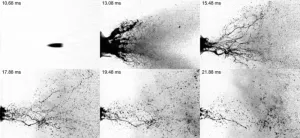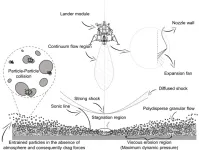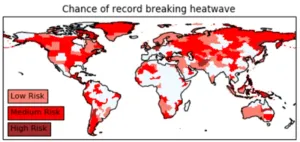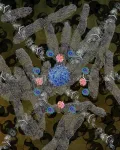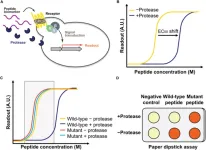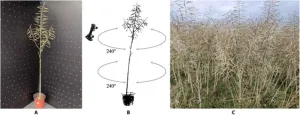(Press-News.org) WASHINGTON, April 25, 2023 – Often left on the surfaces of a crime scene or on the clothes of an accused criminal, blood back spatter can be used as evidence for forensic scientists to reconstruct what occurred. However, the fluid dynamics at play are complicated, and neglecting the interaction between the blood and the muzzle gases from the firearm could skew the results.
In Physics of Fluids, by AIP Publishing, researchers from the University of Illinois Chicago and Iowa State University modeled the behavior of blood drops during secondary atomization to examine how the phenomenon affects a crime scene.
“Primary atomization of blood is caused by a gunshot (bullet). It results in multiple drops spattered in the air,” said author Alexander Yarin. “Some of these drops are big enough to be significantly distorted and torn apart by the air drag forces acting on a drop in flight. Smaller droplets arise during this process, which is called secondary atomization.”
The team examined different starting droplet sizes and confirmed their model with experiments. They found the effect of secondary atomization was significant and predictable: The smaller droplets were easier to sweep up by the firearm’s gases and turn around toward the victim.
“Muzzle gases form a turbulent vortex ring which moves toward a victim from a shooter and pushes the blood droplets from the shooter back to the victim,” said Yarin. “Droplets are also deflected aside, and our predictions showed that some can even land behind the victim, even though initially they were moving from the victim toward the shooter.”
This discovery could explain how a short-range shooter might stay clean from blood stains, like in the famous case of Phil Spector presumably murdering Lina Clarkson while keeping his outfit practically clean.
“The results reveal the usefulness of multiphase flow fluid mechanics for the forensic discipline of back spatter analysis,” said Yarin. “Hopefully, code based on the present results would be used in future crime scene investigations.”
In the future, the group is interested in studying the spatter of brain tissue in similar short-range shooting events. They believe such work could help distinguish between a suicide and a staged homicide.
###
The article “Effect of secondary atomization on blood backspatter affected by muzzle gases” is authored by Kailin Chen, James B. Michael, and Alexander L. Yarin. It will appear in Physics of Fluids on April 25, 2023 (DOI: 10.1063/5.0142146). After that date, it can be accessed at https://doi.org/10.1063/5.0142146.
ABOUT THE JOURNAL
Physics of Fluids is devoted to the publication of original theoretical, computational, and experimental contributions to the dynamics of gases, liquids, and complex fluids. See https://aip.scitation.org/journal/phf.
###
END
Improving bloodstain pattern analysis with fluid dynamics
Secondary atomization can redirect blood droplets, misleading crime scene investigators
2023-04-25
ELSE PRESS RELEASES FROM THIS DATE:
Self-awareness of memory function and clinical progression in cognitively normal older adults
2023-04-25
About The Study: In this study of 436 cognitively normal older adults, unawareness, rather than heightened awareness, of memory decline was strongly associated with future clinical progression, providing further support that discordant self- and informant-reported cognitive decline may provide important information to practitioners.
Authors: Patrizia Vannini, Ph.D., of Brigham and Women’s Hospital in Boston, is the corresponding author.
To access the embargoed study: Visit our For The Media website at this link https://media.jamanetwork.com/
(doi: 10.1001/jamanetworkopen.2023.9964)
Editor’s Note: Please see the article for additional information, including ...
How to land on a planet safely
2023-04-25
WASHINGTON, April 25, 2023 – When a lander descends toward the moon – or a rocky planet, asteroid, or comet – the exhaust plume of the rocket interacts with the surface, causing erosion and kicking up regolith particles. The resulting blanket of dusty debris can create a dangerous brownout effect, limiting visibility and potentially damaging the spacecraft or nearby equipment.
In Physics of Fluids, by AIP Publishing, researchers from Chungnam National University, the University of Edinburgh, Gyeongsang National University, and the Korea Institute of Science and Technology Information ...
Global research reveals countries where record-breaking heatwaves are likely to cause most harm
2023-04-25
A new study has highlighted under-prepared regions across the world most at risk of the devastating effects of scorching temperatures.
The University of Bristol-led research, published today in Nature Communications, shows that unprecedented heat extremes combined with socioeconomic vulnerability puts certain regions, such as Afghanistan, Papua New Guinea, and Central America, most in peril.
Countries yet to experience the most intense heatwaves are often especially susceptible, as adaptation measures are often only introduced after the event. A high chance of record-breaking ...
Using artificial intelligence to create a tsunami early warning system
2023-04-25
Cardiff University media release/Datganiad i’r wasg gan Brifysgol Caerdydd
Under embargo until 16:00 BST/11:00 EST on Tuesday 25 April 2023/O dan embargo tan 16:00 BST/11:00 EST ddydd Mawrth 25 Ebrill 2023
Using artificial intelligence to create a tsunami early warning system
Real-time classification of underwater earthquakes enables earlier and more reliable tsunami alerts
An early warning system that quickly classifies submarine earthquakes and determines the risk of tsunami events has been developed by scientists at Cardiff ...
Researchers at Albert Einstein College of Medicine discover how long-lasting memories form in the brain
2023-04-25
April 25, 2023—(BRONX NY)—Helping your mother make pancakes when you were three…riding your bike without training wheels…your first romantic kiss: How do we retain vivid memories of long-ago events? As described in a paper published online on April 25 in Neuron, researchers at Albert Einstein College of Medicine have found the explanation.
“The ability to learn new information and store it for long periods is one of the brain’s most remarkable features,” said Robert H. Singer, Ph.D., ...
Researchers find rhythmic brain activity helps to maintain temporary memories
2023-04-25
New research shows that rhythmic brain activity is key to temporarily maintaining important information in memory. Researchers at the Del Monte Institute for Neuroscience at the University of Rochester published these findings today in Current Biology that found brain rhythms—or patterns of neuronal activity—organize the bursts of activity in the brain that maintain short-term connections.
“The thought has been that the temporary storage of important information is linked to neurons in the brain that just fire away, retaining that information until it is no longer needed. Recent research has shown that it might not be such persistent ...
Near-universal T cell immunity towards a broad range of bacteria
2023-04-25
Typically T cells of the immune system respond to a specific feature (antigen) of a microbe, thereby generating protective immunity. As reported in the journal Immunity, an international team of scientists have discovered an exception to this rule. Namely, a group of divergent bacterial pathogens, including pneumococci, all share a small highly conserved protein sequence, which is both presented and recognized by human T cells in a conserved population-wide manner.
The study set out to understand immune mechanisms that protect against pneumococcus, a bacterial pathobiont that can reside harmlessly in the upper respiratory mucosae but can also cause infectious ...
Novel living yeast-based dual biosensor for detecting peptide variants
2023-04-25
Biosensors—sensors that can detect biological samples—are powerful tools for understanding the function, composition, and structure of biochemical molecules. Biosensors are often applied for the detection of proteins and their subunits, called peptides, yielding a wide range of biomedical applications. In 2017, researchers from Columbia University in USA engineered a living yeast biosensor by rewiring pheromone-related signaling pathways used by yeast for mating. In the presence of the pheromone peptide, the G-protein coupled receptor (GPCR) could detect the peptide, triggering a cascade that would eventually activate a ...
Sizing them up! An algorithm to accurately quantify rapeseed silique morphology
2023-04-25
Rapeseed or oilseed rape (Brassica napus L.) is an important crop cultivated worldwide for its oil-rich seeds. The rapeseed silique is an organ that plays a role in photosynthesis, sends developmental signals to maturing seeds, and provides a capsule that harbors the seeds. High-yield rapeseed varieties have both a high number and optimal morphology–the form and structure–of siliques. In this regard, rapeseed genotype and cultivation method directly influence the number of siliques that a plant produces. Thus, accurately quantifying silique development parameters is critical for predicting ...
Columbia University launches Center for Precision Psychiatry & Mental Health with $75 million grant from the Stavros Niarchos Foundation
2023-04-25
NEW YORK, April 24, 2023—Columbia University today announced the establishment of the Stavros Niarchos Foundation (SNF) Center for Precision Psychiatry & Mental Health at Columbia University. The center will catalyze the scientific innovation and clinical implementation of precision medicine to advance the prevention, diagnosis, and treatment of mental illness. The center is being established with a $75 million grant from the Stavros Niarchos Foundation (SNF), an international philanthropic organization, as part of SNF’s Global Health Initiative (GHI).
The SNF Center is a joint effort of the Department of Psychiatry at Columbia University Vagelos College of Physicians ...
LAST 30 PRESS RELEASES:
Injectable breast ‘implant’ offers alternative to traditional surgeries
Neuroscientists devise formulas to measure multilingualism
New prostate cancer trial seeks to reduce toxicity without sacrificing efficacy
Geometry shapes life
A CRISPR screen reveals many previously unrecognized genes required for brain development and a new neurodevelopmental disorder
Hot flush treatment has anti-breast cancer activity, study finds
Securing AI systems against growing cybersecurity threats
Longest observation of an active solar region
Why nail-biting, procrastination and other self-sabotaging behaviors are rooted in survival instincts
Regional variations in mechanical properties of porcine leptomeninges
Artificial empathy in therapy and healthcare: advancements in interpersonal interaction technologies
Why some brains switch gears more efficiently than others
UVA’s Jundong Li wins ICDM’S 2025 Tao Li Award for data mining, machine learning
UVA’s low-power, high-performance computer power player Mircea Stan earns National Academy of Inventors fellowship
Not playing by the rules: USU researcher explores filamentous algae dynamics in rivers
Do our body clocks influence our risk of dementia?
Anthropologists offer new evidence of bipedalism in long-debated fossil discovery
Safer receipt paper from wood
Dosage-sensitive genes suggest no whole-genome duplications in ancestral angiosperm
First ancient human herpesvirus genomes document their deep history with humans
Why Some Bacteria Survive Antibiotics and How to Stop Them - New study reveals that bacteria can survive antibiotic treatment through two fundamentally different “shutdown modes”
UCLA study links scar healing to dangerous placenta condition
CHANGE-seq-BE finds off-target changes in the genome from base editors
The Journal of Nuclear Medicine Ahead-of-Print Tip Sheet: January 2, 2026
Delayed or absent first dose of measles, mumps, and rubella vaccination
Trends in US preterm birth rates by household income and race and ethnicity
Study identifies potential biomarker linked to progression and brain inflammation in multiple sclerosis
Many mothers in Norway do not show up for postnatal check-ups
Researchers want to find out why quick clay is so unstable
Superradiant spins show teamwork at the quantum scale
[Press-News.org] Improving bloodstain pattern analysis with fluid dynamicsSecondary atomization can redirect blood droplets, misleading crime scene investigators
